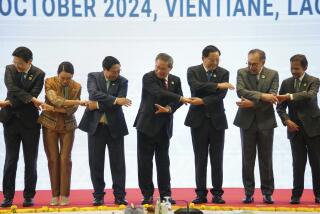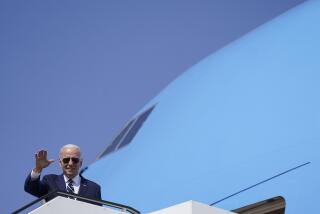6 Asian Nations Agree to Form Free-Trade Zone : Summit: The ASEAN countries also plan friendship and cooperation with Vietnam, Cambodia and Laos.
- Share via
SINGAPORE — Leaders of six Southeast Asian nations, vowing to achieve “peace and prosperity” for their booming region, agreed Tuesday to establish a free-trade zone and step up consultations on security matters.
Ending a two-day summit conference, leaders from the Assn. of Southeast Asian Nations (ASEAN) promised to “constantly seek to safeguard its collective interests” in response to the formation of large economic blocs in North America and Western Europe.
Despite their nations’ long history as a bastion of anti-communism in Asia, the six leaders also agreed to build a relationship of “friendship and cooperation” with Vietnam, Laos and Cambodia in the wake of the signing of a peace settlement among Cambodia’s four warring factions.
ASEAN was formed in the 1960s, partly to settle the border problems left over mainly from French, British and Dutch colonialism. Its members are Singapore, Malaysia, Thailand, Indonesia, Brunei and the Philippines.
The centerpiece of the summit meeting was the final agreement on an ASEAN free trade area, which will be put in place gradually over 15 years.
Similar in concept to the proposed North American free-trade area of Canada, the United States and Mexico, the ASEAN trade pact calls for a lowering of tariffs charged for goods imported from neighboring ASEAN states.
The reduction of tariffs applies mainly to manufactured goods and processed agricultural products, on which duties will be lowered from levels of up to 60% to less than 5% by 2008.
The six nations listed 15 categories of products that will be affected beginning early next year. The list includes such items as plastics, cement, leather products and textiles.
Calling the summit’s decision a “milestone,” Singapore Prime Minister Goh Chok Tong said he could feel a “qualitative change” in the willingness of the six nations to set aside parochial business interests and work toward a common trade policy.
“We must strive to maintain the momentum of economic dynamism in our region, which has in recent years outperformed all other regions,” said Thai Prime Minister Anand Panyarachun. “And the way to do it is to open our markets gradually to one another and allow free flow of trade and investment.”
Western economists noted that trade among ASEAN states is still tiny, accounting for less than 4% of their turnover.
Most of the goods they produce, such as electronic products, appliances and textiles, are shipped to the United States and, increasingly, Japan.
The free-trade agreement will particularly benefit multinational corporations, which will be able to set up a single manufacturing plant in ASEAN countries to serve the entire region.
Currently, high import duties have made regionwide production impractical.
But the trade agreement also includes loopholes allowing member countries to postpone tariff reductions if the imports in question threaten domestic industries.
In the group’s final communique, called the Singapore Declaration, the ASEAN leaders adopted an ambivalent position on another economic question: the formation of an East Asia trade bloc.
The leaders said that “consultations on issues of common concern among East Asian economies, as and when the need arises, could contribute to expanding cooperation among the region’s economies and the promotion of an open and free global trading system.”
The trade bloc, called the East Asian Economic Caucus, was conceived by Malaysian Prime Minister Mahathir Mohammed as a counter to the European Community and the North American Free Trade Area.
But the idea has been dismissed by the Bush Administration because it excludes the United States, while including South Korea, Japan and Vietnam.
Mahathir told a press conference that he would press ahead with the concept by trying to win support in other Asian countries for the caucus. But the idea was basically shelved at this summit because of fears that it might further fan the flames of trade tensions between Asia and Washington.
“We’d like to see a little more understanding from the United States,” the Malaysian leader said.
On security matters, the leaders decided that ASEAN should discuss regional security concerns every year, but no new institutions were created to resolve local disputes.
“ASEAN shall seek avenues to engage member states in new areas of cooperation in security matters,” the declaration said, but it left undecided how it would help to resolve territorial disputes that still afflict the region.
The declaration called for all countries in Southeast Asia--a pointed reference to Vietnam--to adhere to a treaty of “amity and cooperation.” But Hanoi’s hopes of joining ASEAN were put off, ostensibly because of a difference in level of development.
Singapore’s Goh told a news conference that he had briefed other ASEAN leaders on U.S. plans to have a naval logistics office on the island nation after the closure of the U.S. naval base at Subic Bay in the Philippines.
Goh said it is not Singapore policy to ask the United States if its naval vessels carry nuclear weapons, a significant point because it is U.S. policy not to disclose whether vessels are carrying nuclear arms.
Mahathir, who has frequently criticized the U.S. defense posture in Asia in the past, told the news conference that he has no objections to the new U.S. facilities in Singapore as long as they do not exceed the agreed-upon small numbers of personnel. The Bush Administration is planning to send about 200 people to staff the logistics center, adding to the 100 already in Singapore.
Top ASEAN leaders have met just four times in the last 25 years, and the communique Tuesday said they now have agreed to meet formally every three years. They announced that they will appoint a secretary general of the group as part of an effort to build ASEAN into a forceful regional power.
ASEAN at a Glance
ASEAN was formed at the height of the Cold War and gained momentum in the 1980s with its international campaign against Vietnam’s 1978 invasion of Cambodia. Its members are Singapore, Thailand, Malaysia, Indonesia, Brunei and the Philippines. It has a potential market of 300 million people.
Established: By foreign ministers of member states in Bangkok, Thailand, on Aug. 9, 1967.
Headquarters: Jakarta, Indonesia.
Purpose: To foster cooperation among the non-Communist nations of Southeast Asia. Also seeks to accelerate economic growth and expand trade for region. Goals include raising competitiveness in the face of regional economic groups in North America and the European Community. Under trade plan approved Tuesday, the six states will begin in 1993 to cut tariffs on 15 categories, including pharmaceuticals, rubber products, vegetable oil.
Source: Political Handbook of the World, 1991
More to Read
Sign up for Essential California
The most important California stories and recommendations in your inbox every morning.
You may occasionally receive promotional content from the Los Angeles Times.













